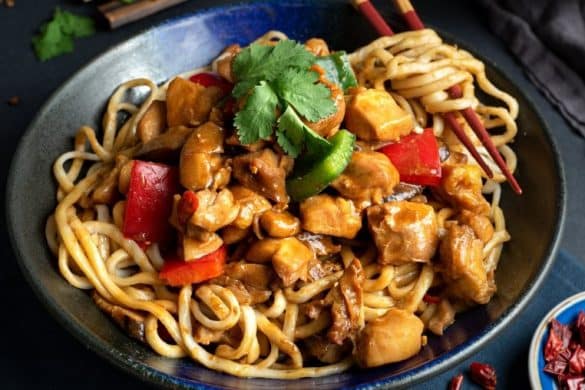General Tso’s Chicken is a very popular Chinese sweet and spicy chicken dish. It is a supposedly named after the Chinese general named General Tso Tsung-tang from the Qing dynasty. Deep-fried chicken coated with a sweet and somewhat spicy sauce that is best served with a bowl/plate of steamed rice.
This iconic Chinese-American dish features crispy chicken pieces coated in a delicious sauce made with soy sauce, ginger, garlic, and chilli peppers. The chicken is deep-fried to golden perfection, resulting in a crispy exterior and tender interior. Each bite is a harmonious blend of savoury, tangy, and slightly spicy goodness that will leave you craving more.

General Tso's Chicken
Ingredients
- 500 g Chicken Breasts skinless, boneless, chopped
- 1 1/4 tbsp Chinese Rice Wine
- 1 tbsp Soy Sauce
- 2 Eggs lightly beaten
- a pinch White Pepper Powder
- 1/4 cup Cornstarch + 1 tblsp
- Oil as required
- 2 Garlic Cloves minced
- 8 to 10 Spring Onions chopped (reserve some for garnish)
- 6 to 8 Dry Red Chillies adjust as per taste
For the Sauce:
- 2 tbsp Dark Soy Sauce
- 1 tbsp White Vinegar
- 2 tsp Chinese Rice Wine
- 1 tbsp Sugar
- 3 tbsp Chicken Stock
- 1 tbsp Ginger minced
- 2 Garlic Cloves minced
- 2 tsp Cornstarch
Instructions
- Mix the Chinese rice wine, soy sauce, eggs, corn starch and white pepper powder in a bowl.
- Add the chicken pieces and toss until evenly coated.
- Mix all the ingredients for sauce and keep aside.
- Heat oil in a deep frying pan over medium flame.
- Fry the marinated chicken pieces for 3 to 4 minutes.
- Remove and drain excess oil.
- Heat 2 tblsp of oil in another pan.
- Saute the garlic, dry red chillies and spring onions for a minute or two.
- Add the fried chicken and stir-fry for a minute.
- Pour the sauce and cook for a minute or until the chicken pieces are evenly coated.
- Remove and transfer to a serving bowl.
- Garnish with spring onions.
- Serve with hot rice.
Sign up for our newsletter
Frequently Asked Questions about General Tso’s Chicken
Is General Tso’s Chicken Spicy?
Yes, General Tso’s Chicken has a spicy flavour. It consists of chicken coated in a sweet and spicy sauce with soy sauce, ginger, garlic, and chilli peppers. You can adjust the level of spiciness according to your preference by reducing the amount of chilli peppers or using milder varieties.
Can I make General Tso’s Chicken without deep frying?
You can make a healthier version of General Tso’s Chicken by baking or stir-frying the chicken instead of deep frying. Coat the chicken pieces with light oil and bake them in the oven until they become crispy. Alternatively, cook the chicken in a small amount of oil over high heat in a stir-fry pan until crisp. These methods produce a lighter, less greasy dish while preserving its delicious flavours.
What can I serve with General Tso’s Chicken?
General Tso’s Chicken pairs well with steamed white rice, which helps balance the spicy flavours. You can also serve it with fried rice, noodles, or steamed vegetables for a healthier option. Popular side dishes complementing General Tso’s Chicken include egg rolls, spring rolls, and vegetable stir-fries.
Can I make General Tso’s Chicken with tofu or vegetables instead of chicken?
Yes, you can make a vegetarian or vegan version of General Tso’s Chicken by substituting the chicken with tofu or various vegetables. Marinate and cook the tofu in the same manner as the chicken to allow it to absorb the flavours of the sauce. Alternatively, use vegetables such as broccoli, cauliflower, bell peppers, or snap peas to create a flavorful and colourful vegetarian stir-fry. Adjust the cooking time to achieve your desired texture for the tofu or vegetables.
Is General Tso’s Chicken a traditional Chinese dish?
While General Tso’s Chicken is famous in American Chinese cuisine, it is not considered a traditional Chinese dish. Its origins are believed to be in the United States, specifically in the Hunan province of China. The dish is named after General Tso Tsung-tang, a Chinese military leader, but it is not commonly found in China. Nevertheless, it has gained popularity and become an iconic dish in Western Chinese cuisine.








